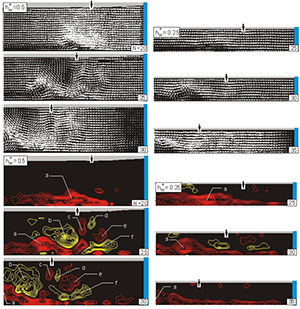You are here
Home ›Three-Dimensional Development of a Shallow Water Vortex: Effect of Water Depth
Three-dimensional development of a shallow water vortex: effect of water depth. As indicated in the previous set of images, generation of a nominally two-dimensional, large-scale vortex can give rise to pronounced three-dimensionality. The nature of such three-dimensional structure and the manner in which it develops is a strong function of the water depth. Evolution of patterns of velocity and vorticity is shown on a vertical laser sheet inclined at an angle b = 7° with respect to the nozzle centerline. The vertical black arrow at the free-surface shows the location of the center of the primary, large-scale vortex. The right boundary of each image corresponds to the nozzle exit. The left and right columns of images represent the three-dimensional development for shallow water depths h*w = hw/W = 0.5 and 0.25 respectively. Images in both depths of water are synchronized at the same starting frame N. Images of vorticity at N = 20 and 25, for the deeper and shallower water respectively, show development of a thick layer of positive vorticity and the initial stage of development of concentration a. The middle row of images shows the vorticity concentration a, which exists at approximately the same location in images N=25 and 30. Note, however, that the development of a in image N = 30 is retarded relative to that in image N = 25. Moreover, the only pronounced concentration of vorticity in the shallowest water at N = 30 is indeed vorticity concentration a. The lowest row of vorticity images shows the remnants of the concentrations shown in the middle row as they translate to the left out of the field of view. It is evident that the shallowest water suppresses development of multiple concentrations of vorticity that occur over the entire depth of deeper water. For both depths of water, the corresponding images of instantaneous velocity show occurrence of a well-defined separation point on the wall associated with development of vorticity concentration a. Minimum and incremental values of vorticity are ωmin = ± 6 sec-1 and Δω = 3 sec-1.
An impulsively-started jet in shallow water gives rise to vortices having a characteristic diameter larger than the water depth. A technique of high-image-density particle image velocimetry allows characterization of the space-time development of the instantaneous flow patterns along planes representing the quasi-two-dimensional and three-dimensional vortex structure. The quasi-two-dimensional patterns exhibit different categories of vortex development and interaction, depending upon the depth of the shallow water layer.
These quasi-two-dimensional patterns are, in turn, related to specific forms of three-dimensional flow structure, which is highly-ordered. A prevalent feature is a vortex orthogonal to, and just ahead of, the primary, quasi-two-dimensional vortex. Its streamline topology, on a plane parallel to the axis of the quasi-two-dimensional vortex, exhibits a separation bubble with a well-defined separatix at the bottom (bed) surface. Moreover, its value of vorticity can exceed that of the quasi-two-dimensional pattern by a factor of two. This feature is consistent for all values of water depth. When the depth becomes sufficiently large, however, the three-dimensional vortex pattern involves an array of vorticity concentrations, which extend across the entire depth of the water.
On a plane very close to the bottom surface (bed), global, instantaneous distributions of velocity and vorticity exhibit large gradients; they are associated with small-scale vorticity concentrations. The corresponding streamline topology of the averaged flow close to the bed, however, exhibits a stable focus and is a direct indicator of the topology well above the bed.

